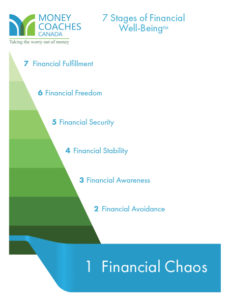By Sheila Walkington, co-founder and CFO Money Coaches Canada and the Women’s Financial Learning Centre
Names and identifying details have been changed for privacy. Story used with permission.
Do you remember the children’s game Chutes and Ladders? Players are moving forward and climbing the ladders when suddenly a roll of the die lands them on a chute that sends them tumbling backwards. When we meet clients in Stage 1 of the 7 Stages of Financial Well-BeingTM – Chaos, it is almost always because a major life event (illness, death of a spouse, job loss, transition to self-employment or divorce), has sent them sliding down a chute into Chaos.
 The base of the 7 Stages of Financial Well-BeingTM pyramid represents those furthest removed from feeling in control and empowered financially. For many, Chaos represents their starting point on their journey to Financial Fulfillment.
The base of the 7 Stages of Financial Well-BeingTM pyramid represents those furthest removed from feeling in control and empowered financially. For many, Chaos represents their starting point on their journey to Financial Fulfillment.
It’s essential to understand that financial well-being comes with a deeper understanding of where you stand with money, emotionally and financially, developing concise and attainable goals, getting organized and implementing a manageable plan to move forward. The 7 Stages of Financial Well-BeingTM is a framework that will help you better understand where you are, and what actions to take, as you move towards Financial Fulfillment.
Each stage on the pyramid is associated with a different set of emotional, behavioral and financial characteristics. You have slipped into Chaos if you can identify with several of these points:
- Emotions: fear, guilt, shame
- Behaviors: avoiding, abdicating, overspending, family conflicts
- Financial status: no savings, taxes not done, bills unpaid, mail unopened, abdicating responsibility to parent or spouse
Brenda’s story
Brenda was 55 years-old when she and her lawyer husband divorced. She admits that throughout her marriage she abdicated her financial responsibilities to her spouse, in part because she lacked confidence in her financial skills and because when she did ask questions it turned into an argument. When the marriage broke down it was revealed that they were not as well off as she had thought.
She is now on her own in the marital home and has some money in RSPs. She has a good job as a nurse, but the pension she has built has to be split with her husband. She feels very vulnerable and uncertain about her financial situation; she realizes that the lifestyle she knew in marriage is no longer sustainable. She doesn’t understand what she’s invested in or whether she’ll be ok in the future, but more immediately she is worried about whether or not she can afford to stay in her home.
How to deal with Chaos
 Whether you find yourself in Chaos from divorce like Brenda or from some other twist in life’s journey, there are things you can do immediately to gain control, find clarity around where you stand financially, and to begin learning money basics.
Whether you find yourself in Chaos from divorce like Brenda or from some other twist in life’s journey, there are things you can do immediately to gain control, find clarity around where you stand financially, and to begin learning money basics.
1. Ask for help
Find a trusted friend, relative, or professional financial advisor to serve as a financial support person — someone that can help keep you balanced and focused.
2. Prioritize your financial concerns and issues
Making a simple priority list is not only practical it also helps minimize the strong emotions that might otherwise cloud your judgment. Ask yourself:
- Do I have enough cash available to cover basic expenses – and for how long?
- What bills are urgent — rent or mortgage payments, child care expenses, insurance payments – and what can wait?
- What expenses need to be covered in the near future (post-dated cheques, scheduled bank withdrawals, tax payments)?
3. Seek professional advice
Once your immediate financial needs are dealt with, it is time to determine what professional financial or legal assistance you might need. Do you already have an “independent financial advisor” to help you? If not, ask for referrals – ideally from someone who has recently been in a similar financial situation to yours.
4. Gather your financial paperwork
Before meeting with your potential advisors, collect all of your financial information — including assets (cash, bank accounts; real estate; household effects; vehicles; investment accounts; RSPs; pension plans; other investments; receivables, business interests, and inheritances) and liabilities (bills; mortgage; lines of credit; credit cards; personal loans, car loans and leases) held separately or jointly with your spouse or partner. Make sure the information is as up-to-date as possible.
5. Create a Net Worth statement
Summarize your assets and liability information by creating a net worth statement so you have a full picture of your finances.
6. Create a Spending and Savings Plan
If you are dealing with divorce or the death of a spouse, consider what your expenses will be when you are living on your own. Start by looking at how much you have spent in the past then make adjustments for your change in circumstances. Collect this information on a Spending and Savings Plan worksheet.

7. Gather tax, legal and insurance documents
Locate recent tax returns, life insurance policies, wills & powers of attorney, safety deposit boxes and other legal documents. You will need this information for your advisors and to update your financial plan.
Tools and Resources
At Money Coaches Canada and the Women’s Financial Learning Centre we have several resources to help you get a handle on your money.
- Net Worth Statement worksheet (free download)
- Spending and Savings Plan worksheet (free download)
- Unstuck: How to get ahead financially and start living the life you want by Money Coaches Canada co-founders Karin Mizgala and Sheila Walkington (purchase the book).
If you are dealing with divorce, we suggest you google search collaborative divorce specialists in your area.
Acknowledge and Appreciate
It’s essential at all of the 7 Stages of Financial Well-Being™ to acknowledge your efforts and appreciate what you have accomplished along the way. As you move out of chaos and start to feel more financial awareness and stability, give yourself the opportunity to experience the satisfaction and benefits of taking charge, learning new skills and establishing a solid foundation. Recognize that you are learning a new language; you can’t master it all overnight. Just take one step at a time.
Next steps
Once you have a good sense of your current financial situation and have a plan to meet your current obligations, it’s time to get clear on your goals for the future and to put the On Track Money Management System in place for managing your day to day finances. You can then turn to the bigger decisions that you have around real estate, investments and retirement.
Don’t worry. You don’t have to navigate these challenging times alone.
After working with a Money Coach, I feel that I have control, predictability and a spending/savings plan. I have pride in what I have accomplished and know that financially I will be ok. I can’t change the past but the future looks good. I have accumulated enough savings in a short time to deal with any unexpected setbacks in life. I am back on track with my finances and know I can make good decisions to get to my goals.
– Rita
A Money Coach can help you make sense of your current finances and create a plan for a worry-free future. Contact us today.
